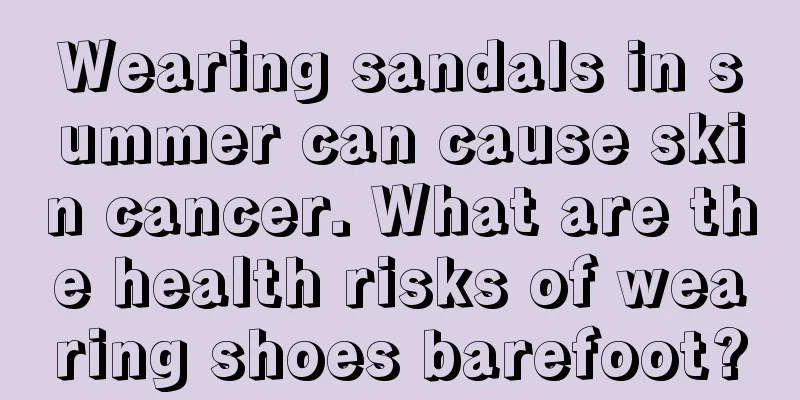Wearing sandals in summer can cause skin cancer. What are the health risks of wearing shoes barefoot?

|
Ladies who like to wear sandals in summer should be aware of the health risks that these shoes bring to the skin, because sandals usually expose a large area of foot skin to the sun, which can easily increase the risk of skin cancer. Flip-flops are quite popular nowadays, but this kind of shoes exposes a large area of the foot skin to direct sunlight. Most people usually don't remember to apply sunscreen or check their feet regularly, so they can easily increase the risk of skin cancer without realizing it. A London hospital has received at least two patients with foot skin cancer caused by sun exposure in the past three months. One of the patients had a malignant skin tumor on his foot for two years, but he had always mistaken it for a bruise and did not pay attention to it. Cancer affecting the foot manifests as a foot tumor, usually formed on the sole of the foot, between the toes or under the toenails. Because this type of tumor does not cause pain or discomfort, it is difficult for patients to detect. What are the health risks of wearing sandals barefoot in summer? 1. Increase the chance of trauma and infection Wearing shoes barefoot exposes a large amount of foot skin, increasing the chance of trauma and mosquito bites. Some people even get blisters on their feet from wearing shoes barefoot. Dust and germs in the air directly adhere to the skin, not only making the feet dirty, but also causing infection if they encounter wounds such as blisters that are worn out. 2. Increased risk of skin cancer Exposure to the sun directly can "bake" the skin. When the skin is directly exposed to the sun for a long time and over a large area, the ultraviolet rays in the sun will stimulate the skin to produce a large number of oxidative free radicals, which will damage skin cell tissues and accelerate the oxidation reaction of melanin production, making the skin dark, rough and lose elasticity, and also reducing the skin's resistance. According to data, sandals and other shoes expose a large area of the foot to the sun directly, and people usually do not apply sunscreen to their feet or do regular checks, which can easily increase the risk of skin cancer. 3. Cause keratosis and dermatitis Without socks to protect, the frequent "close contact" between feet and shoes will easily make the stratum corneum of the heels and other parts that often contact shoes grow thicker and thicker, greatly increasing the chances of calluses and corns. Some people walk barefoot for a long time, and the instep, toes and other parts of the feet that rub against shoes are prone to skin redness, papules, blisters and other symptoms. This is a contact dermatitis caused by skin allergies to leather, rubber and other shoe materials. 4. Prone to fungal infections People's feet are prone to sweating in hot weather. Wearing shoes without socks, especially wearing leather sandals, plastic sandals or even hiking shoes that are not very breathable, will cause the skin of the feet to be directly soaked in sweat. Over time, the part of the foot that touches the shoe will turn white. At the same time, since fungi can easily grow in a humid and hot environment, it can also cause fungal infection of the feet. 5. Catch a cold The fat layer of the feet is thin, the insulation is poor, and the feet are farthest from the heart and have poor blood supply, so the skin temperature of the soles is the lowest and they are very susceptible to cold. Once the feet are cold, it can reflexively cause the capillaries of the upper respiratory tract mucosa to contract, significantly reducing the resistance, and the germs in the air will take advantage of the opportunity to enter, causing heat colds and other diseases. Especially when it rains, bare feet are more likely to get cold, which can cause stomach pain, back pain, leg pain, and dysmenorrhea in women. |
<<: What is melanoma? What factors cause melanoma?
>>: Is renal hamartoma a renal cyst?
Recommend
How to clean dental tartar yourself
Teeth can develop various diseases, including tar...
What are the most common symptoms of bladder cancer
There are many different cancers in life, and bla...
What ointment should I use for acne on my forehead
When the weather gets hot, acne is more likely to...
Indications for cardiopulmonary resuscitation
I believe that many people do not know the treatm...
What disease is the cleft on the tip of the tongue
If you observe carefully, many people will find t...
What causes pain during the recovery period of lumbar radiofrequency ablation?
Some people usually work long hours for the sake ...
The difference between pityriasis versicolor and vitiligo
Some people often confuse pityriasis versicolor w...
Discuss in detail the common methods of treating bone cancer
With the development of society, people's liv...
How to quickly whiten a tanned face?
Many people's faces are white and tender, but...
What is the best effect achieved after radiotherapy and chemotherapy for stage 2B cervical cancer
Most patients survive within 1-2 years, and those...
Why does my breath get bad after eating meat?
Ms. Xie, a reader from Heilongjiang, asked: I am ...
What is the reason for smacking lips when sleeping
Eight hours of adequate sleep a day is the guaran...
What is itchy skin?
Many skin diseases are accompanied by symptoms of...
How can young people prevent sudden death
Excessive smoking and drinking, lack of sleep, la...
Sun-related skin disease
Sunshine dermatitis refers to dermatitis caused b...









